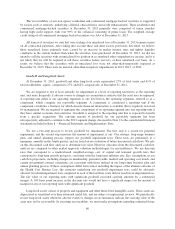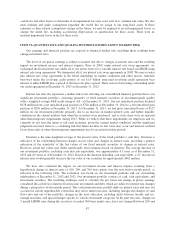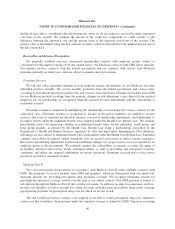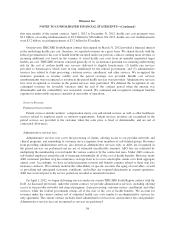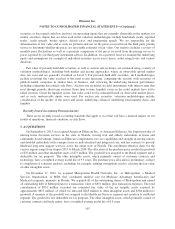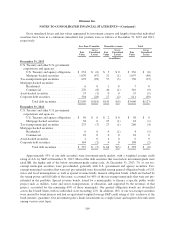Humana 2013 Annual Report Download - page 106
Download and view the complete annual report
Please find page 106 of the 2013 Humana annual report below. You can navigate through the pages in the report by either clicking on the pages listed below, or by using the keyword search tool below to find specific information within the annual report.Humana Inc.
NOTES TO CONSOLIDATED FINANCIAL STATEMENTS—(Continued)
decline in fair value is considered other-than-temporary when we do not expect to recover the entire amortized
cost basis of the security. We estimate the amount of the credit loss component of a debt security as the
difference between the amortized cost and the present value of the expected cash flows of the security. The
present value is determined using the best estimate of future cash flows discounted at the implicit interest rate at
the date of purchase.
Receivables and Revenue Recognition
We generally establish one-year commercial membership contracts with employer groups, subject to
cancellation by the employer group on 30-day written notice. Our Medicare contracts with CMS renew annually.
Our military services contracts with the federal government and our contracts with various state Medicaid
programs generally are multi-year contracts subject to annual renewal provisions.
Premiums Revenue
We bill and collect premium remittances from employer groups and members in our Medicare and other
individual products monthly. We receive monthly premiums from the federal government and various states
according to government specified payment rates and various contractual terms. Changes in revenues from CMS
for our Medicare products resulting from the periodic changes in risk-adjustment scores derived from medical
diagnoses for our membership are recognized when the amounts become determinable and the collectibility is
reasonably assured.
Premiums revenue is estimated by multiplying the membership covered under the various contracts by the
contractual rates. Premiums revenue is recognized as income in the period members are entitled to receive
services, and is net of estimated uncollectible amounts, retroactive membership adjustments, and adjustments to
recognize rebates under the minimum benefit ratios required under the Health Care Reform Law. We estimate
policyholder rebates by projecting calendar year minimum benefit ratios for the individual, small group, and
large group markets, as defined by the Health Care Reform Law using a methodology prescribed by the
Department of Health and Human Services, separately by state and legal entity. Beginning in 2014, Medicare
Advantage are also subject to minimum benefit ratio requirements under the Health Care Reform Law. Estimated
calendar year rebates recognized ratably during the year are revised each period to reflect current experience.
Retroactive membership adjustments result from enrollment changes not yet processed, or not yet reported by an
employer group or the government. We routinely monitor the collectibility of specific accounts, the aging of
receivables, historical retroactivity trends, estimated rebates, as well as prevailing and anticipated economic
conditions, and reflect any required adjustments in current operations. Premiums received prior to the service
period are recorded as unearned revenues.
Medicare Part D
We cover prescription drug benefits in accordance with Medicare Part D under multiple contracts with
CMS. The payments we receive monthly from CMS and members, which are determined from our annual bid,
represent amounts for providing prescription drug insurance coverage. We recognize premiums revenue for
providing this insurance coverage ratably over the term of our annual contract. Our CMS payment is subject to
risk sharing through the Medicare Part D risk corridor provisions. In addition, receipts for reinsurance and low-
income cost subsidies as well as receipts for certain discounts on brand name prescription drugs in the coverage
gap represent payments for prescription drug costs for which we are not at risk.
The risk corridor provisions compare costs targeted in our bids to actual prescription drug costs, limited to
actual costs that would have been incurred under the standard coverage as defined by CMS. Variances exceeding
96


